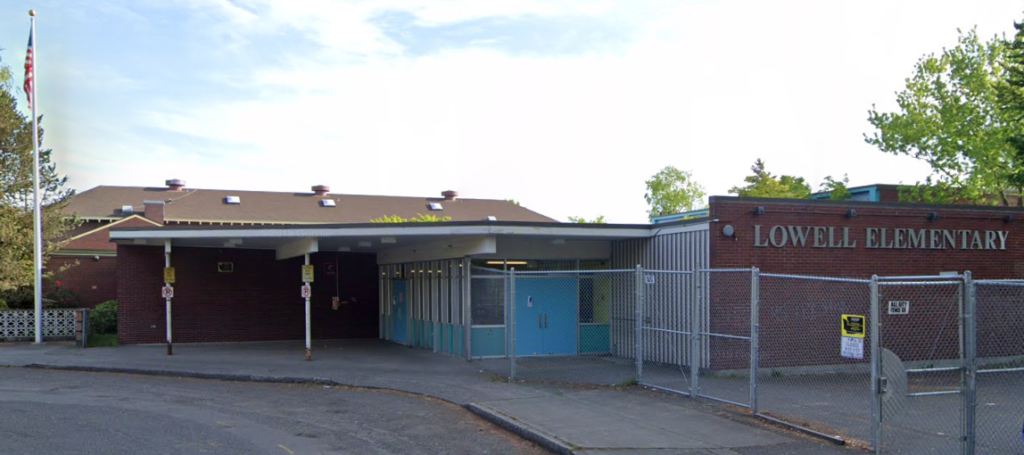The Capitol Hill EcoDistrict is working in partnership with Odessa Brown Children’s Clinic and Country Doctor Community Health Center to bring a school-based health center (SBHC) to Lowell Elementary School.
Lowell Elementary School is located in the Capitol Hill neighborhood of Seattle and is the assigned elementary school for all downtown homeless shelters. The disproportionately high population of homeless and low-income students is faced with many hardships, including a lack of access to health care. The instability of their housing situations has led to a high turnover rate, and subsequently negative outcomes for both students and teachers.
Sarah Talbot, principal of Lowell, has been instrumental in leading the efforts to establish a local school-based health center. Before Sarah took the helm at Lowell, the school had seven principals in four years.
“There was some negative press and a lot of concerns from families and teachers, and it just was a hard place to be for everyone who was there. So when I came in, it was a pretty rich soil to grow in,” Sarah said. “People are really ready to come together and do something for students.
“The students who come to Lowell are often pretty impacted by poverty. They often have experienced trauma, and they’re historically coming from families who have not been well served by schools. So it’s very important for us to be warm and welcoming, focused on the social emotional well-being of our students and to connect with the community organizations around us to help us meet the needs of families. Our kids can’t learn anything until they know that we’re on their side. Without a little bit of trust, we don’t get very far. We know that we have to build that first. And our families have a lot of needs in terms of health care and housing and food insecurity and jobs. There’s a lot of need. We know that we’re an educational institution. I know a lot about teaching and learning. I do not know a lot about housing. So we know that we need to partner with other organizations to make sure that we can do as much as possible.”
The proposed business plan for a school-based health center at Lowell states that an SBHC would provide affordable, conveniently located, and easy-to-access health care services for students and their families, as well school staff members, thus bridging the gap for families who do not consistently have access to care.
“Helping a five-year-old is fun and really rewarding and wonderful. But helping a five-year-old and sending them back into a family system that doesn’t have the support or help that they need is a Sisyphean task,” Sarah said. “You’re not solving the problem. The five-year-old’s issues are a symptom of a whole family need. We believe that families are systems, and that supporting one member of the family isn’t particularly useful. We need to support the whole system.”
The Lowell SBHC will provide primary health care services, immunizations, dental care, vision care, mental health services, and behavioral health services. The plan also includes trauma-informed training for teachers and translation services to facilitate communication between SHBC staff and patients for whom English is a second language.
“We see ourselves as a place that can be a connector, a hub of connections for families,” Sarah said. “We can’t provide families with health care needs, but we can connect them to someone who can. And the school-based health center is about that. It’s about ensuring that everyone has what they need at our building. True family engagement is families engaged in the learning process, families understanding what kids are learning, knowing how their students are learning, seeing how their students engage at school, and being able to support that and have ideas about that and give us feedback about that. They do that best if they can be in our building. And our families are so busy. Chasing down social services is a full-time job at least, and they work and have kids, they have things to do. So if we can meet some of their outside needs in the building, they’re more likely to be able to engage in the academic part of their children’s lives. If parents are coming to school for health care, or for their children’s health care, then they’re there. They might see the social worker because she’s right next door. They might get some other needs met, they might visit the classroom. And if they’re in the classroom, then they’re seeing how their child learns in the classroom, how the teaching is happening, what the content is, and they can do more to support their children and learning. I don’t mean more time, more energy, more effort. I mean more effectiveness. I think parents are doing plenty. But if we’re on the same page, and we’re doing the same things, it’s going to be more effective.
“Parents are the best teachers. They are the people who know [the students] best and will advocate for them long-term. We’re going to advocate for them as hard as we can for as long as we can, but their family – they’re going to be there forever. So we want those folks engaged and helping us, and we know that we can’t ask for help from our families without easing some of the burden that they’re carrying.”
Capitol Hill EcoDistrict staffer Akeyla Jimerson believes the Lowell SBHC would help remove physical, emotional, and behavioral health barriers to student success, while supporting staff in better serving students and strengthening relationships between the school and student families.
“Most of our students haven’t been with us for very long – we don’t have multiple years to meet the needs of students. We sometimes have a day,” Sarah said. “Our commitment is to help families connect and build their own net of resources so that their students can thrive and to improve the lives of students educationally in whatever time period we have them. We focus first on social emotional learning and make sure that kids have a friend. We also want them to have at least two adults in the building that they can turn to and trust. We focus on making sure that they feel welcome and at home at school before we try to do any intensive academic interventions. Those academic interventions are a little bit like spinning your wheels if kids aren’t connected. So we try to get them connected first, and then we have a commitment to moving students on grade level. That’s our goal: to make sure that everybody learns and grows, that kids who are behind catch up, and that we do it in the time that we have.”

